

|
| ÖSTERREICH | AUSTRIA |
| Bundesland: Steiermark | Styria |
| Stadt: Graz |
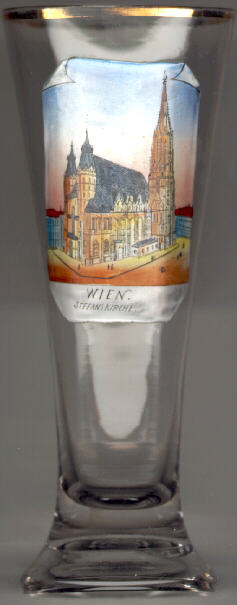
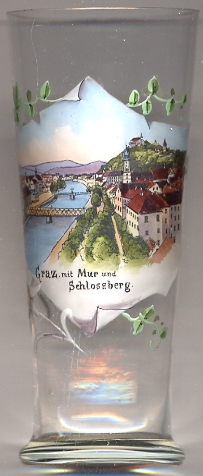 The earliest document mentioning Graz dates from 1128. However, archaeologists have found remains of a village from about 800 on the slope of the Schlossberg.
The name Graz is probably derived from the Slavic word gradec ('little castle'). In the Middle Ages, the town became the centre of Styria.
1281 special privileges were granted to the city by King Rudolf I.
In the 15th century Graz was residence of Emperor Friedrich III (1415–1493). Friedrich III
was the first Roman Emperor from the Habsburg family and the last Emperor to
be crowned by a pope (1452 by Pope Nicholas V) in Rome.
1564, under Archduke Karl II, Graz became residence of Inner Austria (Styria, Carinthia, Carniola, Trieste and Istria).
His son Archduke Ferdinand (1578–1637, Regent of Inner Austria 1595, King of Bohemia 1617, King of Hungary 1618)
moved the court to Vienna upon his election as Roman-German Emperor (Ferdinand II) in 1619.
Today Graz is Austria's second-biggest city and capital of the province Steiermark (Styria).
The earliest document mentioning Graz dates from 1128. However, archaeologists have found remains of a village from about 800 on the slope of the Schlossberg.
The name Graz is probably derived from the Slavic word gradec ('little castle'). In the Middle Ages, the town became the centre of Styria.
1281 special privileges were granted to the city by King Rudolf I.
In the 15th century Graz was residence of Emperor Friedrich III (1415–1493). Friedrich III
was the first Roman Emperor from the Habsburg family and the last Emperor to
be crowned by a pope (1452 by Pope Nicholas V) in Rome.
1564, under Archduke Karl II, Graz became residence of Inner Austria (Styria, Carinthia, Carniola, Trieste and Istria).
His son Archduke Ferdinand (1578–1637, Regent of Inner Austria 1595, King of Bohemia 1617, King of Hungary 1618)
moved the court to Vienna upon his election as Roman-German Emperor (Ferdinand II) in 1619.
Today Graz is Austria's second-biggest city and capital of the province Steiermark (Styria).
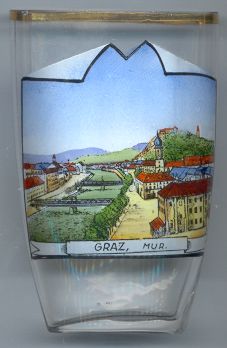 Since 1999 the old town centre of Graz is listed as World Cultural Heritage by the UNESCO; Eggenberg Palace in the city borough of Eggenberg was added
to that list in 2010.
(see also list of other UNESCO heritage sites depicted on glasses of this collection)
Since 1999 the old town centre of Graz is listed as World Cultural Heritage by the UNESCO; Eggenberg Palace in the city borough of Eggenberg was added
to that list in 2010.
(see also list of other UNESCO heritage sites depicted on glasses of this collection)
Graz was selected to be European Capital of Culture for 2003 by the Council of the European Union.
Archduke Franz Ferdinand (1863–1914) was born in Graz. He was nephew of Emperor Franz Joseph I and became heir to the throne after the suicide of Crown Prince Rudolf 1889 and the death of his father Archduke Karl Ludwig 1896. His assassination in Sarajevo caused World War I. He was buried in Artstetten.
Another son of Graz is the world-famous conductor Karl Böhm (1894–1981). He had his
first engagement at the opera house of Graz and came to the State Opera in
Vienna in 1921. He was director of the State Opera
1943–1945 and 1954–1956.
| 1. Bezirk: Innere Stadt | 1st district: Inner City |
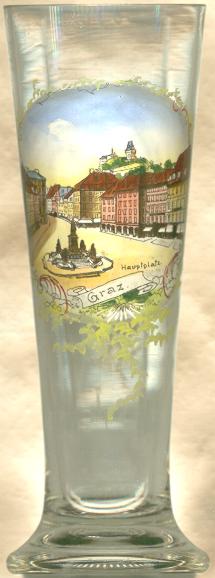
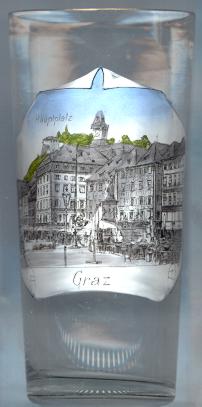
The  Hauptplatz (Main Square) is the centre of the town and was created most likely around 1160 by Margrave Otakar III.
The buildings on the square date back to the Middle Ages and received their present form in the 17th and 18th century.
Hauptplatz (Main Square) is the centre of the town and was created most likely around 1160 by Margrave Otakar III.
The buildings on the square date back to the Middle Ages and received their present form in the 17th and 18th century.
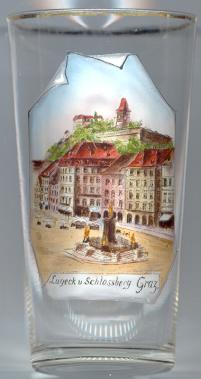
The  Erzherzog-Johann-Brunnen, the fountain
in the centre of the square commemorating Archduke Johann, a
brother of Emperor Franz II/I, was erected in 1878.
The four figures surrounding his statue represent the four main rivers of the old,
undivided, Duchy of Styria: Enns, Mur, Drau and Sann. The latter two of these rivers are
in that part of old Styria, which since 1918 is part of Slovenia (Štajerska) where these
rivers are called Drava and Savinja.
Erzherzog-Johann-Brunnen, the fountain
in the centre of the square commemorating Archduke Johann, a
brother of Emperor Franz II/I, was erected in 1878.
The four figures surrounding his statue represent the four main rivers of the old,
undivided, Duchy of Styria: Enns, Mur, Drau and Sann. The latter two of these rivers are
in that part of old Styria, which since 1918 is part of Slovenia (Štajerska) where these
rivers are called Drava and Savinja.
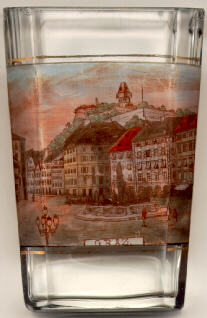
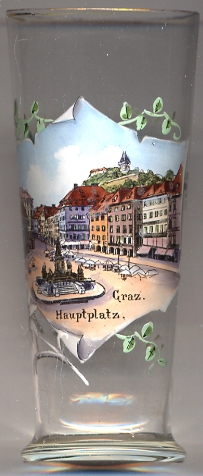
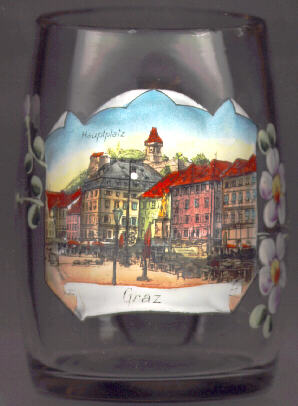
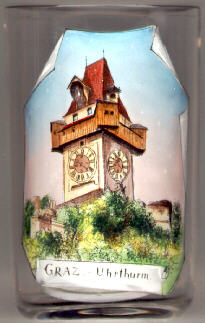
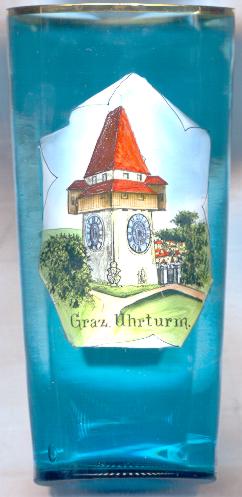
The  Uhrturm (Clock Tower) originally was built as a watch tower in the 13th century.
It was transformed to its present appearance including the giant clock faces in 1559/69.
The clockwork was improved in 1712. The hands for the minutes were added and are shorter (!)
than the older ones for the hours.
Uhrturm (Clock Tower) originally was built as a watch tower in the 13th century.
It was transformed to its present appearance including the giant clock faces in 1559/69.
The clockwork was improved in 1712. The hands for the minutes were added and are shorter (!)
than the older ones for the hours.
After Austria was defeated by Napoleon in 1809 (Peace of Schönbrunn), the fortress on the Schlossberg was demolished by the French.
The citizens of Graz however saved the Uhrturm and the Glockenturm (Bell Tower)
by paying a ransom of 2,978 gulden and 41 kreutzer.
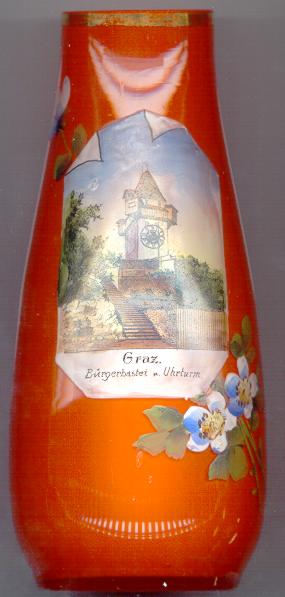
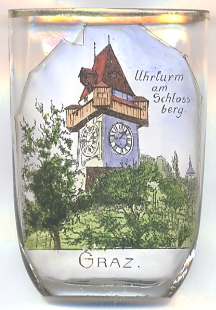
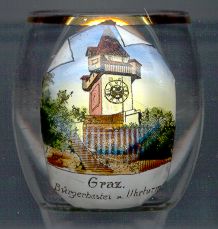
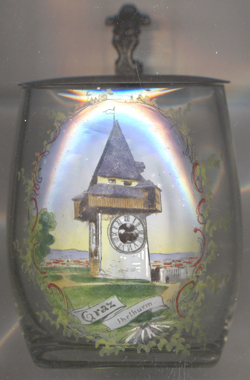
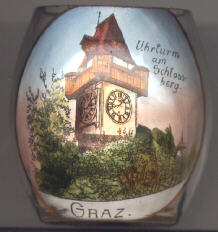
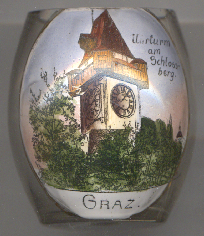
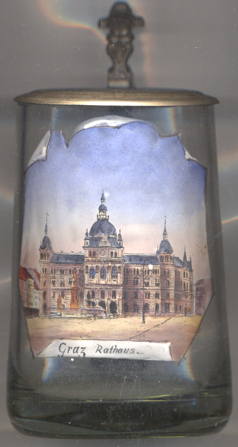
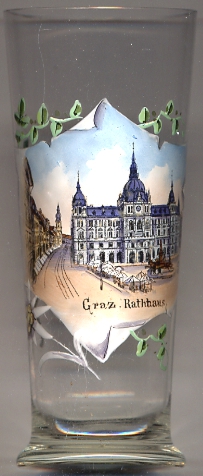
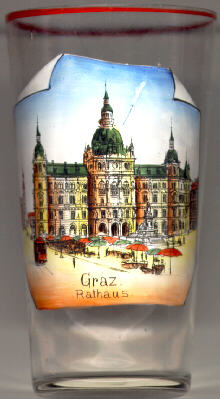
The  Rathaus (Town Hall): the first town hall on the Hauptplatz was built around 1550
and was replaced by a new building in Classicist style in 1805–1807. The building that we see today
is the third town hall on this place and was built 1887–1893.
Rathaus (Town Hall): the first town hall on the Hauptplatz was built around 1550
and was replaced by a new building in Classicist style in 1805–1807. The building that we see today
is the third town hall on this place and was built 1887–1893.
In 1957 most of the statues of kings and
emperors were removed because they were considered to be broken and were assumed to have become a danger for the public
(which probably was not true).
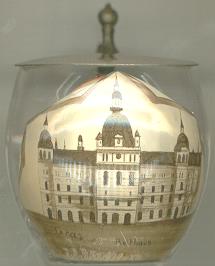
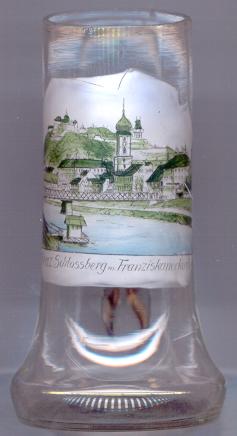
The  Franziskanerkirche (church of the Franciscans)
is one of the oldest churches of Graz. The church and the monastery were already mentioned in a document in 1239. At that time
they were situated outside the medieval city-wall. The old church was completed in 1277. The present church was erected in 1515–1519,
the tower was added in the first half of the 17th century and received its Baroque onion-roof in 1643. The belfry on top of the church roof contains the oldest bell of
Graz, cast in 1272. During World War II the church suffered some damage
but was restored after the war. The modern stained-glass windows of the chancel were made by the artist Franz Felfer, the pulpit was designed by
the sculptor Alexander Silveri, the tabernacle was created by Ulf Meyer.
Franziskanerkirche (church of the Franciscans)
is one of the oldest churches of Graz. The church and the monastery were already mentioned in a document in 1239. At that time
they were situated outside the medieval city-wall. The old church was completed in 1277. The present church was erected in 1515–1519,
the tower was added in the first half of the 17th century and received its Baroque onion-roof in 1643. The belfry on top of the church roof contains the oldest bell of
Graz, cast in 1272. During World War II the church suffered some damage
but was restored after the war. The modern stained-glass windows of the chancel were made by the artist Franz Felfer, the pulpit was designed by
the sculptor Alexander Silveri, the tabernacle was created by Ulf Meyer.
The
 Albrechtsbrücke [foreground]
was first built in 1883 as an iron bridge, at that time replacing a temporary wooden bridge constructed in 1830/43.
The bridge was named for Archduke Albrecht of Austria-Teschen (1817–1895), son of Archduke Karl of Austria-Teschen and grandson of Emperor Leopold II.
Albrecht was commanding general of the Austrian army since 1845 and fieldmashal since 1863, best known as victor of the battle of Custoza (1866).
In 1920, the bridge was renamed Tegetthoffbrücke for Admiral Wilhelm Freiherr von Tegetthoff (1827–1871), victor of the battles of Helgoland (1864)
and Lissa (today Vis, 1866). In 1974–1975 it was replaced by a modern bridge.
Albrechtsbrücke [foreground]
was first built in 1883 as an iron bridge, at that time replacing a temporary wooden bridge constructed in 1830/43.
The bridge was named for Archduke Albrecht of Austria-Teschen (1817–1895), son of Archduke Karl of Austria-Teschen and grandson of Emperor Leopold II.
Albrecht was commanding general of the Austrian army since 1845 and fieldmashal since 1863, best known as victor of the battle of Custoza (1866).
In 1920, the bridge was renamed Tegetthoffbrücke for Admiral Wilhelm Freiherr von Tegetthoff (1827–1871), victor of the battles of Helgoland (1864)
and Lissa (today Vis, 1866). In 1974–1975 it was replaced by a modern bridge.
[http://www.streetsofgraz.at/feed.ccc?n=1283&x=ABCDEFGH&d=1854, http://www.streetsofgraz.at/doc.ccc?n=1283&d=1847&x=ABCDEFGH,
https://de.wikipedia.org/wiki/Albrecht_von_%C3%96sterreich-Teschen]
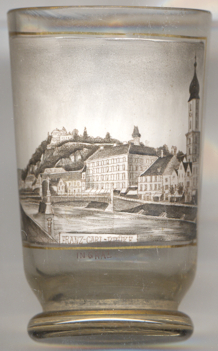
Glass no. 4700 [near left] shows a view of Graz with the bridge
 Franz-Carl-Brücke
Franz-Carl-Brücke
[https://de.m.wikipedia.org/wiki/Datei:Graz_Schlossberg_Ferdinandsbr%C3%BCcke_1855.jpg]
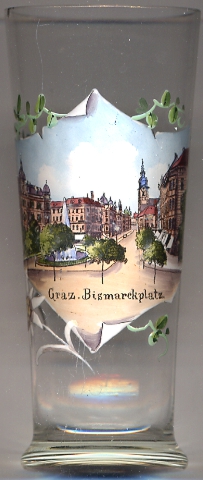
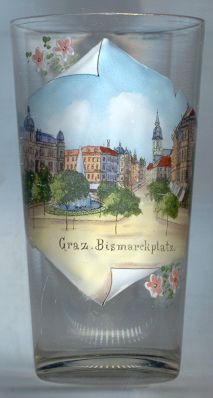
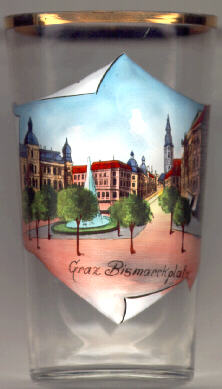
The name of the square  Am Eisernen Tor ("At the Iron Gate") [left and right]
is derived from the former town gate which stood in this place. In the early 15th century the name
"eysnein Tur" (Iron Gate) probably referred to an armoury within the gatehouse.
When the town fortifications were enlarged in the Renaissance, the new gate built in
1570/74 was also called "eyseres Tor" (Outer Gate). The square was created when
the fortifications of the town were pulled down in 1860. At the first the square was
named "Eisenthorplatz", later "Auerspergplatz" after Anton Alexander Count Auersperg
(the poet Anastasius Grün). The fountain on the square was created in his honour too.
Between 1899 and 1947 the square was called "Bismarckplatz" (as inscribed on the glasses) after the German Reichskanzler
Otto von Bismarck, founder of the German Empire of 1871.
(Several glasses of this collection show other Bismarck monuments.)
Am Eisernen Tor ("At the Iron Gate") [left and right]
is derived from the former town gate which stood in this place. In the early 15th century the name
"eysnein Tur" (Iron Gate) probably referred to an armoury within the gatehouse.
When the town fortifications were enlarged in the Renaissance, the new gate built in
1570/74 was also called "eyseres Tor" (Outer Gate). The square was created when
the fortifications of the town were pulled down in 1860. At the first the square was
named "Eisenthorplatz", later "Auerspergplatz" after Anton Alexander Count Auersperg
(the poet Anastasius Grün). The fountain on the square was created in his honour too.
Between 1899 and 1947 the square was called "Bismarckplatz" (as inscribed on the glasses) after the German Reichskanzler
Otto von Bismarck, founder of the German Empire of 1871.
(Several glasses of this collection show other Bismarck monuments.)
In 1928 the Türkensäule (Turks Column), which commemorates the victory over the
Turks at Mogersdorf in 1664, was transfered from the Jakominiplatz onto this square.
(The picture on the glasses shows the square without the column.)
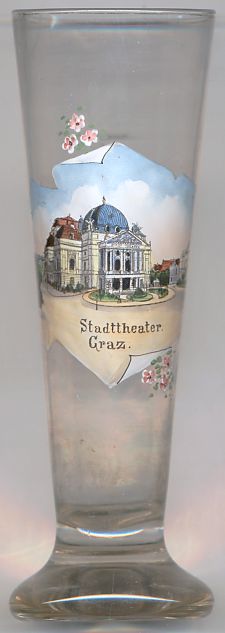
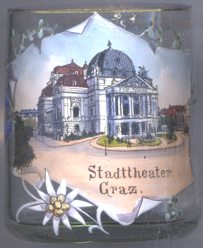
The  Opernhaus [far left, no. 2337, and right, no. 3365]
was built in 1898–1899 by the famous architects Ferdinand Fellner and Hermann Helmer.
The theater, built in Baroque revival style, was named Stadttheater (Municipal Theatre) at the time.
During World War II it suffered some minor damages of the front parts. Nevertheless, the building was not restoerd to its
prior appearance; instead, the façade was simplified, most of the ornamental statues and stuccos were removed,
and the portico was pulled down. The interior decorations, however, are still preserved.
Major renovation works were carried out in 1983–1985, including the construction of a steel and glass skywalk
between the theatre and the new stage warehouse (i. e. the stage house of the old Thalia-Theater).
The original iron curtain, painted by Alexander Rothaug, was also restored on that occasion.
The theatre originally had a capacity of 1,800 seats plus 200 standing; today it has 1,267 seats and 100 standing.
It is used by the "Bühnen Graz" for opera, musical and ballet performances.
Opernhaus [far left, no. 2337, and right, no. 3365]
was built in 1898–1899 by the famous architects Ferdinand Fellner and Hermann Helmer.
The theater, built in Baroque revival style, was named Stadttheater (Municipal Theatre) at the time.
During World War II it suffered some minor damages of the front parts. Nevertheless, the building was not restoerd to its
prior appearance; instead, the façade was simplified, most of the ornamental statues and stuccos were removed,
and the portico was pulled down. The interior decorations, however, are still preserved.
Major renovation works were carried out in 1983–1985, including the construction of a steel and glass skywalk
between the theatre and the new stage warehouse (i. e. the stage house of the old Thalia-Theater).
The original iron curtain, painted by Alexander Rothaug, was also restored on that occasion.
The theatre originally had a capacity of 1,800 seats plus 200 standing; today it has 1,267 seats and 100 standing.
It is used by the "Bühnen Graz" for opera, musical and ballet performances.
(See also list of further buildings by Fellner and Helmer
that are depicted on glasses of this collection.)
| 2. Bezirk: St. Leonhard | 2nd district: St. Leonhard |
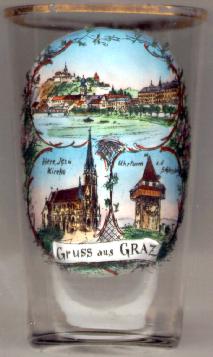
The  Herz-Jesu-Kirche (Holy Heart Church) [left, no. 469: bottom left picture]
was built between 1881 and 1891 in Neo-Gothic style by the architect
Georg von Hauberrisser (jun.). Its spire (109.6 m) is third in height of all Austrian churches
after St. Stephen's Cathedral in Vienna (137 m) and the
New Cathedral in Linz (134 m).
Herz-Jesu-Kirche (Holy Heart Church) [left, no. 469: bottom left picture]
was built between 1881 and 1891 in Neo-Gothic style by the architect
Georg von Hauberrisser (jun.). Its spire (109.6 m) is third in height of all Austrian churches
after St. Stephen's Cathedral in Vienna (137 m) and the
New Cathedral in Linz (134 m).
| 11. Bezirk: Mariatrost | 11th district: Mariatrost |
(see also list of other basilicae minores depicted on glasses of this collection)
The village of Maria Trost became part of Graz (11th district) in 1938.
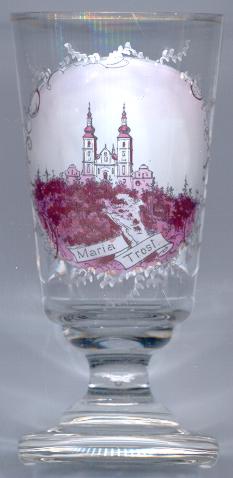
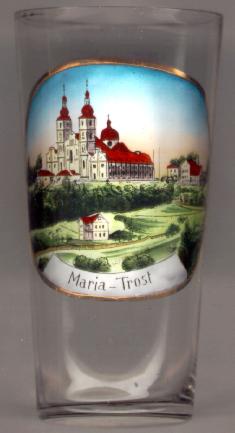
The  basilica Maria Trost (Our Lady of Consolation)
stands on the place of a a chapel of 1708 which was part of a small castle from 1660.
The chapel was placed in the hands of the Paulaner order and was recognized as a
pilgrimage site in 1711.
The wooden Figure of Our Lady was created around 1460. The new church was started to be built in 1714.
While the first service was already held in 1719, the church was completed only in 1799.
In 1786, the monastery was closed by Emperor Josef II and the church became parish church.
The monastery was reopened in 1846 by the order of the Franciscans.
In 1999, Pope John Paul II granted the church the title Basilica minor.
The official ceremony took place in 2000 on the feast of Nativity of Our Lady (Mariä Geburt, September 8).
basilica Maria Trost (Our Lady of Consolation)
stands on the place of a a chapel of 1708 which was part of a small castle from 1660.
The chapel was placed in the hands of the Paulaner order and was recognized as a
pilgrimage site in 1711.
The wooden Figure of Our Lady was created around 1460. The new church was started to be built in 1714.
While the first service was already held in 1719, the church was completed only in 1799.
In 1786, the monastery was closed by Emperor Josef II and the church became parish church.
The monastery was reopened in 1846 by the order of the Franciscans.
In 1999, Pope John Paul II granted the church the title Basilica minor.
The official ceremony took place in 2000 on the feast of Nativity of Our Lady (Mariä Geburt, September 8).
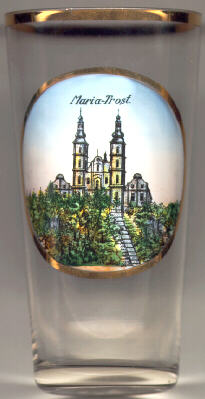
| 14. Bezirk: Eggenberg | 14th district: Eggenberg |
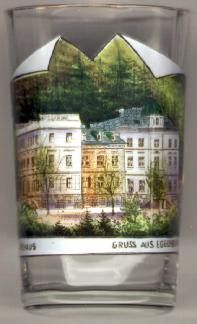
The  Kaltwasserheilanstalt in Eggenberg was opened in 1874 as a sanatorium for
neurological, respiratory and gastrointestinal diseases. Located near Eggenberg Palace
it had to overcome some difficulties to become popular, and in the 1890s it even was in
danger of becoming bankrupt. Later, the cures offered by the sanatorium (cold-water cures,
steam, carbonic water and light baths) made it more popular so that is was enlarged in 1901.
Prior to 1917 it specialized in electrotherapy.
In 1940 the sanatorium was remodelled and converted into a hostel for apprentices.
Kaltwasserheilanstalt in Eggenberg was opened in 1874 as a sanatorium for
neurological, respiratory and gastrointestinal diseases. Located near Eggenberg Palace
it had to overcome some difficulties to become popular, and in the 1890s it even was in
danger of becoming bankrupt. Later, the cures offered by the sanatorium (cold-water cures,
steam, carbonic water and light baths) made it more popular so that is was enlarged in 1901.
Prior to 1917 it specialized in electrotherapy.
In 1940 the sanatorium was remodelled and converted into a hostel for apprentices.
The village of Eggenberg became part of the city of Graz in 1938 (14th district).
![[scale]](lineal.jpg)